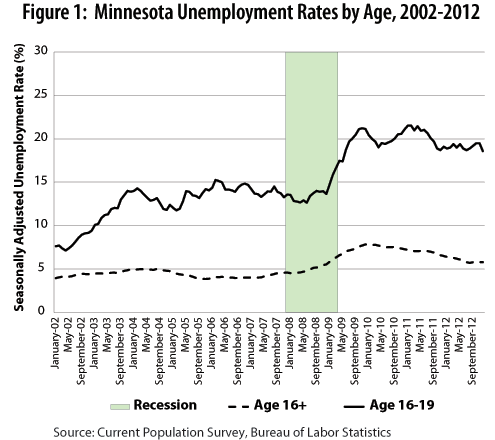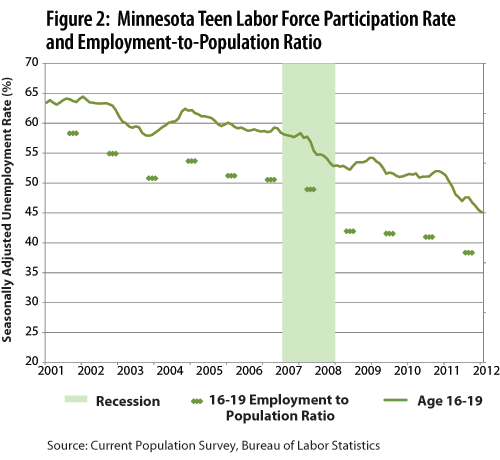by Nick Dobbins
April 2013
In the wake of our recent recession young Minnesotans looking for a summer job face a significant challenge. Today the economies of both Minnesota and the United States are slowly recovering, and labor markets are improving along with them. Minnesota's overall unemployment rate has been improving since 2009, and we have nearly matched our pre-recession job total. Some of these improvements will benefit teen job seekers who, along with many other Minnesotans, are still dealing with a challenging labor market.
Most teens, even among those participating in the labor force, are not engaged in full-time work and are not financially dependent on their wages. However, they are still considered 'unemployed' if they are able to work, actively seek employment, and unable to find it. As Figure 1 illustrates, unemployment rates are much higher for teens in Minnesota than for the workforce at large. According to the Current Population Survey, by December of 2012 18.6 percent of Minnesotans ages 16 to 19 were unemployed compared to 5.8 percent for the entire workforce in the state. Nationally the picture is even worse with an unemployment rate of 23.5 percent for teens in December 2012.

One encouraging sign is that the annual average teen unemployment rate in Minnesota actually decreased from 2011 to 2012. That marks the first such improvement since unemployment spiked in 2009.
When jobs are scarce, young people are more likely than older workers to be shut out of the workforce. For instance, between July 2007 and July 2009 the unemployment rate in Minnesota rose by 2.9 percent while the teen unemployment rate rose by 5.8 percent. This pattern, which holds not just for this recession in Minnesota but in past recessions and nationwide as well, is at least partially attributable to teens facing stiffer competition from more experienced workers who have lost their jobs in a tightening market and are forced to take positions they wouldn't seek otherwise.
Both state and national teen labor force participation rates and employment-to-population ratios have been dropping since long before the recession. These trends may be largely attributable to teens eschewing early employment in favor of additional education or other value-added pursuits like internships.
Figure 2 illustrates the declines over the past decade. The employment-to-population ratio, which is calculated by dividing the number of employed 16-19 year-olds by their total population and multiplying the result by 100, dropped sharply following the recession from an average of 50.5 percent in third quarter 2007 to 41.9 percent during the same period in 2009. Despite this steep decline Minnesota's ratio remains markedly stronger than the nation's at 38.3 in summer 2012 compared with 26.2 nationwide.

While Minnesota tends to outperform the nation for teen employment, one area in which we lag is in the racial employment gap. Paralleling similar issues in the adult workforce, teens from racial minority groups in Minnesota have disproportionately low employment and labor force participation rates when compared to the population as a whole. In 2012 the state average unemployment rate for all teens was 19.1 percent, while it was 24.2 percent for Hispanic teens and a whopping 32.2 percent for black teens. This is despite the labor force participation rates that are lower for these same groups. While the statewide average was 47.7 percent, only 45.7 percent of Hispanic teens participated in the labor market, with an even smaller 29.8 percent of black teens.
Opinions differ on how important a healthy teen labor market is to the larger economy. While more young people are choosing to bypass paid employment in favor of internships, college, and other pursuits, for some teens the ability to find a job is incredibly important to their current and future financial well-being. Many of the teens included in this cohort are former high school students who have just completed their education and are entering the workforce for the first time as adults. For those people especially, the costs of not being able to find a good job can be astronomical.
One recent study has estimated the financial cost of the estimated 6.7 million 16 to 24 year olds in America who are neither working nor attending school to be $1.6 trillion1 over the course of their lives. The Economic Policy Institute, which has studied the issue of graduates entering the job market during the recession, estimates that current grads could see their earnings suffer for 10 to 15 years simply because they are entering the labor market at an inopportune time2.
While the exact impact is hard to quantify, the potential benefits of a teen's first job are plentiful. From learning how to search and interview for a job, to developing the necessary soft work skills, to the money in their pockets, summer jobs can offer teens a number of advantages whether they intend join the workforce permanently or leave their jobs to continue their education in the fall.
While teen workers in Minnesota take summer jobs across every industry, they tend to be concentrated in a handful of industries. In the summer of 2011, which is the most recent data available, employment for Minnesotans age 14 to18 was higher in Accommodation and Food Service and in Retail Trade than it was in all other industries combined by a substantial margin. The industries shown in Table 1 accounted for over 80 percent of teen summer employment.
As Table 1 shows, employment in the largest industries for teen workers appeared to level off between the summers of 2010 and 2011 after suffering precipitous drops in the immediate aftermath of the recession. Small declines in less vital teen industries such as Health Care and Social Assistance and Arts, Entertainment, and Recreation were balanced by marginal gains in Accommodation and Food Service and in Retail Trade, the current drivers of teen employment. In addition to the stabilizing employment picture, wages in these industries also showed healthy growth between 2010 and 2011.
| Teen (Age 14-18) Employment Data Comparison, Minnesota: Summer 2007, 2010, 2011 | ||||||||
|---|---|---|---|---|---|---|---|---|
| Number Employed | Average Monthly Earnings | |||||||
| Summer 2007 | Summer 2010 | Summer 2011 | % Change 2010-2011 | Summer 2007 | Summer 2010 | Summer 2011 | % Change 2010-2011 | |
| All Sectors | 121,383 | 83,126 | 84,108 | 1.2% | $631 | $643 | $680 | 5.8% |
| Accomm. and Food Service | 38,732 | 29,363 | 29,441 | 0.3% | $562 | $559 | $588 | 5.2% |
| Retail Trade | 32,332 | 19,267 | 19,399 | 0.7% | $584 | $572 | $607 | 6.1% |
| Health Care and Social Assistance | 7,908 | 6,126 | 5,977 | -2.4% | $710 | $717 | $757 | 5.6% |
| Arts, Entertainment, and Recreation | 6,098 | 4,599 | 4,567 | -0.7% | $530 | $466 | $532 | 14.2% |
| Other Services | 4,893 | 3,514 | 3,484 | -0.9% | $464 | $510 | $538 | 5.5% |
| Public Administration | 4,664 | 3,389 | 3,384 | -0.1% | $443 | $422 | $431 | 2.1% |
| Manufacturing | 4,035 | 2,324 | 2,467 | 6.2% | $1,163 | $1,333 | $1,510 | 13.3% |
| *Third quarter data for each year. | ||||||||
| Source: U.S. Census Bureau, Longitudinal Employer-Household Dynamics, Quarterly Workforce Indicators for Minnesota. | ||||||||
While there are many characteristics that set the summer teen labor market apart from the job picture as a whole, a strong connection still exists. With that in mind, looking at employment forecasts for the most important industries for summer teen employment can give us a sense of the type of job market they will face. As Table 2 indicates, forecasts for all major industries for teen workers show positive growth between 2012 and 2013, with Accommodation and Food Service and Retail Trade each showing 1 percent or better growth. This bodes well for teens looking to enter the workforce this summer.
| Projected Summer Employment by Industry, All Ages | |||
|---|---|---|---|
| Industry | Estimated 2012 Q3 Employment | Projected 2013 Q3 Employment | Percent Change |
| Total, All Industries | 2,748,460 | 2,792,725 | 1.6% |
| Accommodation and Food Services | 206,015 | 208,296 | 1.1% |
| Retail Trade | 281,189 | 284,206 | 1% |
| Health Care and Social Assistance | 418,661 | 429,402 | 2.5% |
| Arts, Entertainment, and Recreation | 37,613 | 38,146 | 1.4% |
| Other Services | 117,075 | 118,356 | 1% |
| Public Administration | 392,664 | 396,399 | 0.9% |
| Manufacturing | 310,623 | 313,189 | 0.8% |
| Source: Minnesota Department of Employment and Economic Development, LMI Short-Term Industry Projections | |||
Minnesota is still recovering from the effects of the recession, and difficult job markets historically hit teens harder than the market at large. Additionally, the long-term trend appears to be towards decreased employment for teens. It follows that we may not see the same recovery in teen employment rates that we have begun seeing in the labor force as a whole. However, there does appear to be stabilization or improvement in some important indicators including total employment numbers in key industries. Together, this suggests that while the teen summer job market isn't likely to see a dramatic improvement this year, it could be marginally easier for teens to find work than it was last summer.
There are a variety of resources and organizations aimed at helping teens navigate the job market. Many have a specific focus, such as woodworking, agriculture, or business. In addition to the selected programs listed below, DEED maintains a list of youth employment and training service providers across the state of Minnesota, which is searchable by county.
If you're a youth looking to join the workforce yourself, you can also improve your chances by having a well written resume that has been proofread by at least one additional person, finding as many references as possible from people you know already in the workforce, and being sure to pursue whatever opportunities you're able to find. While it may be more difficult to find a job in the current market, early success may make a big difference later on.
This is a partial list of Minnesota youth employment programs and services. Many available opportunities are not listed here so please do your own research on what may be available in your community.
Minnesota Conservation Corps: environmental services, statewide
Tree Trust Youth Summer Employment Program: paid work in a variety of positions. Washington, Dakota, and suburban Hennepin counties.
Youth Express: Program in the metro area, including a 15-session class and business apprentice opportunities.
Youth Job Corps: paid internships for low-income students, St. Paul
YouthLead: services for disadvantaged youth, Ramsey County
Elpis Enterprises: woodworking, screen printing, and experiential workshops, St. Paul
Cookie Cart: bakery operations (paid), career readiness, workforce skills, and customer service, North Minneapolis
EMERGE StreetWerks: summer employment program and youth services, Minneapolis
MN Landscape Arboretum, Urban Garden Youth Employment: entrepreneurship and leadership, Metro
Youth Farm and Market Project: personal development and farming, Minneapolis and St. Paul
1Belfield, Clive R., Henry M. Levin and Rachel Rosen. January 2012. "The Economic Value of Opportunity Youth" Page 26.
2Shierholz, Heidi, Natalie Sabadish and Nicholas Finio. April 10, 2013. Economic Policy Institute, Briefing Paper #360. Page 2.